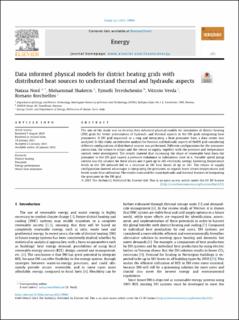| dc.contributor.author | Nord, Natasa | |
| dc.contributor.author | Shakerin, Mohammad | |
| dc.contributor.author | Tereshchenko, Tymofii | |
| dc.contributor.author | Verda, Vittorio | |
| dc.contributor.author | Borchiellini, Romano | |
| dc.date.accessioned | 2021-03-01T09:28:33Z | |
| dc.date.available | 2021-03-01T09:28:33Z | |
| dc.date.created | 2021-02-11T11:45:36Z | |
| dc.date.issued | 2021 | |
| dc.identifier.issn | 0360-5442 | |
| dc.identifier.uri | https://hdl.handle.net/11250/2730838 | |
| dc.description.abstract | The aim of the study was to develop data informed physical models for simulation of district heating (DH) grids for better presentation of hydraulic and thermal aspects in the DH grids integrating heat prosumers. A DH grid organized as a ring and integrating a heat prosumer from a data center was analyzed. In this study, an extensive analysis for thermal and hydraulic aspects of the DH grid considering different configurations of distributed sources was performed. Different configurations for the prosumer connection, the return to return and the return to supply, together with the pressure and temperature control, were investigated. The results showed that increasing the share of renewable heat from the prosumer to the DH grid caused a pressure imbalance in substations close to it. Variable speed pump control was the solution for these issues and it gave up to 34% electricity savings. Lowering temperature levels in the DH network led to a decrease in DH heat losses of up to 14%. The return to supply configuration showed advantages in integrating the prosumer, as regards lower return temperatures and better waste heat utilization. The results indicated the main hydraulic and thermal features of integrating the prosumer in the DH grid. | en_US |
| dc.language.iso | eng | en_US |
| dc.publisher | Elsevier | en_US |
| dc.relation.uri | https://www.sciencedirect.com/science/article/pii/S0360544221002140 | |
| dc.rights | Navngivelse 4.0 Internasjonal | * |
| dc.rights.uri | http://creativecommons.org/licenses/by/4.0/deed.no | * |
| dc.title | Data informed physical models for district heating grids with distributed heat sources to understand thermal and hydraulic aspects | en_US |
| dc.type | Peer reviewed | en_US |
| dc.type | Journal article | en_US |
| dc.description.version | publishedVersion | en_US |
| dc.source.volume | 222 | en_US |
| dc.source.journal | Energy | en_US |
| dc.identifier.doi | https://doi.org/10.1016/j.energy.2021.119965 | |
| dc.identifier.cristin | 1888803 | |
| dc.relation.project | Norges forskningsråd: 262707 | en_US |
| dc.relation.project | Norges forskningsråd: 257660 | en_US |
| cristin.ispublished | true | |
| cristin.fulltext | preprint | |
| cristin.qualitycode | 2 | |

